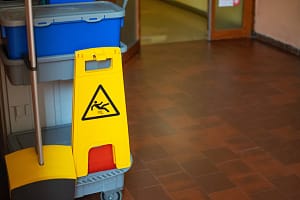Worker safety is something all businesses must focus on, but at times, that focus isn’t in the areas it needs to be. For example, policies may exist for long working hours, and regular checks for fire safety may be completed, but are there sufficient policies and procedures in place for lone workers?
Lone working is one of the riskiest elements of any job, and in some industries, this risk is heightened greatly. Many companies do, of course, have certain rules in place for lone workers but occasionally, these are in place to reduce or manage risk, and not manage issues should something arise.
A man down alarm, or worker down alarm as they are often referred to adds a further degree of safety and security to a working environment. Today, in this blog, we look at how they work and why they could prove to be essential for every lone worker on your books.
What is a man-down alarm?
A man-down alarm is a safety feature, often incorporated into smartphones as an app, that raises an alarm when a lack of movement is detected. Of course, there are times when workers may be relatively still, but the sensitivity of the technology allows for an accurate detection of what is classed as a man down.
Where a worker has not moved for a certain amount of time, the alarm automatically activates, enabling the worker to simply click a button on their smartphone to send a message to indicate all is ok. Should the alarm sound and no response be made, an alert is sent to the workplace supervisor to indicate that there could be an issue. With the live location reporting, the supervisor can then locate the individual and send the appropriate assistance.
This simple-to-use tool enables lone or remote workers to benefit from rapid response and appropriate care should an injury occur, or an incident take place.
How does a man-down alarm work?
Man-down alarms are typically built with specific sensors in place that detect movement or the lack of it. Some though can be a simple app that is installed onto your phone. With there being no need for additional wearable tech to carry around, this is often a good way to ensure lone workers have a way to raise an alarm.
Where separate devices are used, they often consist of motion sensors, as touched upon above. Where these sensors detect no movement for a specific period, an alarm will be raised. In some cases, tilt sensors are also incorporated. These can be useful for indicating if there has been a sudden fall from height or collapse.
The alarms also factor in both manual and automatic activation. This means that should an employee realise something isn’t right; they can swiftly raise the alarm discreetly and request assistance. Where automatic activation is required, the alarm simply sends an alert to the supervisor or call handler as soon as a lack of movement is detected.
These smart systems also come with built-in GPS. This enables a rapid tracking of the location, enabling help to be sent out quickly.
Man down app
The app is slightly different to the other wearable tech and is often preferred. With less tech to wear or carry but the same results possible, it makes sense to incorporate the system into already existing technology.
Why should businesses consider a man-down app or alarm?
There is a wealth of industries where people are left to work by themselves for long periods. Having a trustworthy device or app to enhance worker safety means that these individuals can feel more confident in their working environment.
Rapid emergency response
The moment an alarm is activated, the supervisor or call centre receives an alert, they can then proceed accordingly to have the situation resolved and the worker helped. In the event the alarm was activated by mistake or there was no incident, the employee can simply signal that all is well, and the alert will be cancelled.
Enhanced compliance with regulations
Every employer must show they take employee safety seriously and have robust measures in place to help prevent accidents and incidents. Providing man-down apps or alarms enhances the levels of compliance with safety rules and shows a proactive approach from the business to help employees. Furthermore, it fosters a better relationship between employer and employee as the worker will see that the company is encouraging safety measures and doing its best to mitigate issues.
Reduced labour costs
With an app, employees can actively mark themselves as safe, reducing the need for frequent checks from other workers or security teams. This can lower labour costs as everything becomes automated.
Minimised false alarms
With some devices, alarms will be activated by a sudden change in movement. If someone was particularly active, then suddenly stopped, the device may think something has happened and raise the alarm. In some cases, this sends a direct alert to the alarm centre or call handler. Should it be a false alarm, call handlers or supervisors could be trying to manage a call that doesn’t require any action. With certain alarms or apps though, the alarm first alerts the employee. They can then deactivate the alarm and report back all is well. If they do not deactivate the alarm, the alert is escalated, and the alarm receiver will then act accordingly.
Simple integration
Individual devices may have to be calibrated with existing systems at additional cost to the business. While this isn’t the case for all man down alarm systems, it could be for some. Opting for a tried and tested app instead allows for simple integration. With Android and Apple compatibility, it’s simply a case of installing the app to a smartphone and it is ready to go.
Which roles benefit from man down alarms or apps?
Numerous roles could benefit from the addition of man down apps or alarms. Any industry where people work alone, at height or in volatile areas would see advantages in arming their employees with an alarm or app.
Common areas where man-down apps and alarms are incorporated include:
- Healthcare and social service professionals
- Security teams
- Utility technicians
- Warehouse workers
- Delivery drivers
- Farmers and those in agriculture
- Retail and hospitality
- Construction workers
As you can see, man down alarms can be implemented in a host of industries and enhance the safety of all lone workers. With flexible check-ins as part of the set up too, the systems can be calibrated to match the level of work being done. This gives workers in all environments the ability to notify their team that they are safe within a timeframe that suits the workload and environment.
Put worker safety first today and investigate lone worker alarms for added peace of mind!






Leave a Comment